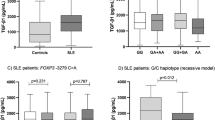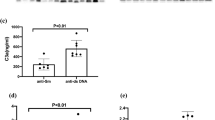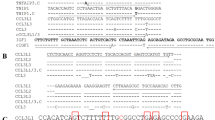Abstract
Complete deficiency of complement C4 is among the strongest genetic risk factors for human systemic lupus erythematosus (SLE). C4 is a constituent of the RP–C4–CYP21–TNX (RCCX) module in the human leukocyte antigen (HLA) that exhibits inter-individual copy-number and gene-size variations. Here, we studied two North-African families with complete C4 deficiency and SLE. The first included a Moroccan male SLE patient (1P) and a sibling, who were both homozygous for HLA-A*02 B*17 DRB1*07. The second had an Algerian female SLE patient (2P) homozygous for HLA-A*01 B*17 DRB1*13. Early SLE disease onset, the presence of photosensitive rashes, anti-Ro/SSA, renal disease and high titers of antinuclear antibodies were the common features of complete C4 deficiency. Southern blot analyses showed that 1P had monomodular RCCX with a long C4A, whereas 2P had bimodular RCCX with one long C4A and one short C4B. Genomic DNA fragments for these mutant genes were amplified and sequenced. A C>T transition that created the R540X nonsense mutation in C4A was found in 1P. An identical 4-bp insertion that generated the Y1537X nonsense mutation was discovered in both C4A and C4B of 2P. The high concordance of SLE and C4 deficiency among patients with non-DR3 and non-DR2 haplotypes underscores the importance of C4 proteins in the protection against SLE.
This is a preview of subscription content, access via your institution
Access options
Subscribe to this journal
Receive 6 digital issues and online access to articles
$119.00 per year
only $19.83 per issue
Buy this article
- Purchase on Springer Link
- Instant access to full article PDF
Prices may be subject to local taxes which are calculated during checkout





Similar content being viewed by others
References
Reid KBM, Porter RR . The proteolytic activation systems of complement. Ann Rev Biochem 1981; 50: 433–464.
Walport MJ . Complement-part I. New Engl J Med 2001; 344: 1058–1066.
Hauptmann G, Tappeiner G, Schifferli J . Inherited deficiency of the fourth component of human complement. Immunodefic Rev 1988; 1: 3–22.
Yu CY, Hauptmann G, Yang Y, Wu YL, Birmingham DJ, Rovin BH et al. Complement deficiencies in human systemic lupus erythematosus (SLE) and SLE nephritis: epidemiology and pathogenesis. In: Tsokos GC, Gordon C, Smolen JS (eds). Systemic Lupus Erythematosus: A Companion to Rheumatology. Elsevier: Philadelphia, 2007, pp 203–213.
Rahman A, Isenberg DA . Systemic lupus erythematosus. N Engl J Med 2008; 358: 929–939.
Tsokos GC, Gordon C, Smolen JS . Systemic Lupus Erythematosus: A Companion to Rheumatology, 1st edn. Mosby-Elsevier: Philadelphia, 2007.
Tsao BP, Wu H . The genetics of human lupus. In: Wallace LC, Hahn BH (eds). Dubois’ Lupus Erythematosus, 7th edn. Lippincott Williams & Wilkins: Philadelphia, 2007, pp 54–81.
Vyse TJ, Kotzin BL . Genetic susceptibility to systemic lupus erythematosus. Annu Rev Immunol 1998; 16: 261–292.
Botto M, Walport MJ . C1q, autoimmunity and apoptosis. Immunobiology 2002; 205: 395–406.
Shen LM, Wu LC, Sanlioglu S, Chen R, Mendoza AR, Dangel A et al. Structure and genetics of the partially duplicated gene RP located immediately upstream of the complement C4A and C4B genes in the HLA class III region: molecular cloning, exon-intron structure, composite retroposon and breakpoint of gene duplication. J Biol Chem 1994; 269: 8466–8476.
Yang Z, Mendoza AR, Welch TR, Zipf WB, Yu CY . Modular variations of HLA class III genes for serine/threonine kinase RP, complement C4, steroid 21-hydroxylase CYP21 and tenascin TNX (RCCX): a mechanism for gene deletions and disease associations. J Biol Chem 1999; 274: 12147–12156.
Chung EK, Yang Y, Rennebohm RM, Lokki ML, Higgins GC, Jones KN et al. Genetic sophistication of human complement C4A and C4B and RP-C4-CYP21-TNX (RCCX) modules in the major histocompatibility complex (MHC). Am J Hum Genet 2002; 71: 823–837.
Wu YL, Savelli SL, Yang Y, Zhou B, Rovin BH, Birmingham DJ et al. Sensitive and specific real-time PCR assays to accurately determine copy-number variations (CNVs) of human complement C4A, C4B, C4-Long, C4-Short and RCCX modules: Elucidation of C4 CNVs in 50 consanguineous subjects with defined HLA genotypes. J Immunol 2007; 179: 3012–3025.
Dangel AW, Mendoza AR, Baker BJ, Daniel CM, Carroll MC, Wu L-C et al. The dichotomous size variation of human complement C4 gene is mediated by a novel family of endogenous retroviruses which also establishes species-specific genomic patterns among Old World primates. Immunogenetics 1994; 40: 425–436.
Chu X, Rittner C, Schneider PM . Length polymorphism of the human complement component C4 gene is due to an ancient retroviral integration. Exp Clin Immunogenet 1995; 12: 74–81.
Yu CY . The complete exon-intron structure of a human complement component C4A gene: DNA sequences, polymorphism, and linkage to the 21-hydroxylase gene. J Immunol 1991; 146: 1057–1066.
Yang Y, Chung EK, Wu YL, Savelli SL, Nagaraja HN, Zhou B et al. Gene copy number variation and associated polymorphisms of complement component C4 in human systemic erythematosus (SLE): low copy number is a risk factor for and high copy number is a protective factor against European American SLE disease susceptibility. Am J Hum Genet 2007; 80: 1037–1054.
Mauff G, Luther B, Schneider PM, Rittner C, Strandmann-Bellinghausen B, Dawkins R et al. Reference typing report for complement component C4. Exp Clin Immunogenet 1998; 15: 249–260.
Yu CY, Chung EK, Yang Y, Blanchong CA, Jacobsen N, Saxena K et al. Dancing with complement C4 and the RP-C4-CYP21-TNX (RCCX) modules of the major histocompatibility complex. Progr Nucl Acid Res Mol Biol 2003; 75: 217–292.
Yu CY, Belt KT, Giles CM, Campbell RD, Porter RR . Structural basis of the polymorphism of human complement component C4A and C4B: gene size, reactivity and antigenicity. EMBO J 1986; 5: 2873–2881.
Dodds AW, Ren X-D, Willis AC, Law SKA . The reaction mechanism of the internal thioester in the human complement component C4. Nature 1996; 379: 177–179.
Isenman DE, Young JR . The molecular basis for the differences in immune hemolysis activity of the Chido and Rodgers isotypes of human complement component C4. J Immunol 1984; 132: 3019–3027.
Schifferli JA, Hauptmann G, Pierre-Paccaud J . Complement-mediated adherence of immune complexes to human erythrocytes. Difference in the requirements for C4A and C4B. FEBS Lett 1987; 213: 415–418.
Yang Y, Chung EK, Zhou B, Lhotta K, Hebert LA, Birmingham DJ et al. The intricate role of complement C4 in human systemic lupus erythematosus. Curr Direct Autoimmun 2004; 7: 98–132.
Fredrikson GN, Gullstrand B, Schneider PM, Witzel-Schlomp K, Sjoholm AG, Alper CA et al. Characterization of non-expressed C4 genes in a case of complete C4 deficiency: identification of a novel point mutation leading to a premature stop codon. Hum Immunol 1998; 59: 713–719.
Lokki M-L, Circolo A, Ahokas P, Rupert KL, Yu CY, Colten HR . Deficiency of human complement protein C4 due to identical frameshift mutations in the C4A and C4B genes. J Immunol 1999; 162: 3687–3693.
Rupert KL, Moulds JM, Yang Y, Arnett FC, Warren RW, Reveille JD et al. The molecular basis of complete C4A and C4B deficiencies in a systemic lupus erythematosus (SLE) patient with homozygous C4A and C4B mutant genes. J Immunol 2002; 169: 1570–1578.
Yang Y, Lhotta K, Chung EK, Eder P, Neumair F, Yu CY . Complete complement components C4A and C4B deficiencies in human kidney diseases and systemic lupus erythematosus. J Immunol 2004; 173: 2803–2814.
Uring-Lambert B, Mascart-Lemone F, Tongio M-M, Goetz J, Hauptmann G . Molecular basis of complete C4 deficiency. a study of three patients. Hum Immunol 1989; 24: 125–132.
Dumas R, Hauptmann G, Chayon E, Bascoul S, Serre A, Baldet P et al. Hereditary deficiency of the fourth component of complement (C4) in a child with a lupus-like disorder. Arch Fr Pediatr 1986; 43: 267–269.
Barba G, Rittner C, Schneider PM . Genetic basis of human complement C4A deficiency. Detection of a point mutation leading to nonexpression. J Clin Invest 1993; 91: 1681–1686.
Blanchong CA, Zhou B, Rupert KL, Chung EK, Jones KN, Sotos JF et al. Deficiencies of human complement component C4A and C4B and heterozygosity in length variants of RP-C4-CYP21-TNX (RCCX) modules in Caucasians: the load of RCCX genetic diversity on MHC-associated disease. J Exp Med 2000; 191: 2183–2196.
Saxena K, Kitzmiller KJ, Wu YL, Zhou B, Esack N, Hiremath L et al. Great genotypic and phenotypic diversities associated with copy-number variation of complement C4 and RP-CY-CYP21-TNX (RCCX) modules: a comparison of Asian Indian and European American populations. Mol Immunol 2009 (in press; e-pub ahead of print 8 January; PMID: 19135723).
Castano-Rodriguez N, Diaz-Gallo LM, Pineda-Tamayo R, Rojas-Villarraga A, Anaya JM . Meta-analysis of HLA-DRB1 and HLA-DQB1 polymorphisms in Latin American patients with systemic lupus erythematosus. Autoimmun Rev 2008; 7: 322–330.
Fernando MM, Stevens CR, Sabeti PC, Walsh EC, McWhinnie AJ, Shah A et al. Identification of two independent risk factors for lupus within the MHC in United Kingdom families. PLoS Genet 2007; 3: e192.
Arbuckle MR, McClain MT, Rubertone MV, Scofield RH, Dennis GJ, James JA et al. Development of autoantibodies before the clinical onset of systemic lupus erythematosus. N Engl J Med 2003; 349: 1526–1533.
Shmerling RH . Autoantibodies in systemic lupus erythematosus—there before you know it. N Engl J Med 2003; 349: 1499–1500.
Prodeus AP, Goerg S, Shen LM, Pozdnyakova OO, Chu L, Alicot EM et al. A critical role for complement in maintenance of self-tolerance. Immunity 1998; 9: 721–731.
Chen Z, Koralov SB, Kelsoe G . Complement C4 inhibits systemic autoimmunity through a mechanism independent of complement receptors CR1 and CR2. J Exp Med 2000; 192: 1339–1351.
Yang Y, Chung EK, Zhou B, Blanchong CA, Yu CY, Füst G et al. Diversity in intrinsic strengths of the human complement system: serum C4 protein concentrations correlate with C4 gene size and polygenic variations, hemolytic activities and body mass index. J Immunol 2003; 171: 2734–2745.
Wu YL, Higgins GC, Rennebohm RM, Chung EK, Yang Y, Zhou B et al. Three distinct profiles of serum complement C4 proteins in pediatric systemic lupus erythematosus (SLE) patients: tight associations of complement C4 and C3 protein levels in SLE but not in healthy subjects. Adv Exp Med Biol 2006; 586: 227–247.
Hebert LA, Cosio FG, Neff JC . Diagnostic significance of hypocomplementemia. Kidney Int 1991; 39: 811–821.
Manzi S, Navratil JS, Ruffing MJ, Liu CC, Danchenko N, Nilson SE et al. Measurement of erythrocyte C4d and complement receptor 1 in systemic lupus erythematosus. Arthritis Rheum 2004; 50: 3596–3604.
Chung EK, Wu YL, Yang Y, Zhou B, Yu CY . Human complement components C4A and C4B genetic diversities: complex genotypes and phenotypes. Curr Protoc Immunol 2005, Chapter 13: Unit 13.8.
Awdeh ZL, Alper CA . Inherited structural polymorphism of the fourth component of human complement. Proc Natl Acad Sci USA 1980; 77: 3576–3580.
Sim E, Cross S . Phenotyping of human complement component C4, a class III HLA antigen. Biochem J 1986; 239: 763–767.
Blanchong CA, Chung EK, Rupert KL, Yang Y, Yang Z, Zhou B et al. Genetic, structural and functional diversities of human complement components C4A and C4B and their mouse homologs, Slp and C4. Int Immunopharmacol 2001; 1: 365–392.
Johnson CA, Densen P, Hurford Jr RK, Colten HR, Wetsel RA . Type I human complement C2 deficiency. A 28-base pair gene deletion causes skipping of exon 6 during RNA splicing. J Biol Chem 1992; 267: 9347–9353.
Acknowledgements
We are indebted to the patients and their family members who contributed to this study. This work was supported by Grants 1R01 AR050078, 1R01 AR054459 from the NIAMS, NIAID, NIDDK and the Office of the Director, the National Institutes of Health, and by a pilot grant from the Lupus Foundation of America.
Author information
Authors and Affiliations
Corresponding author
Additional information
Supplementary Information accompanies the paper on Genes and Immunity website (http://www.nature.com/gene)
Supplementary information
Rights and permissions
About this article
Cite this article
Wu, Y., Hauptmann, G., Viguier, M. et al. Molecular basis of complete complement C4 deficiency in two North-African families with systemic lupus erythematosus. Genes Immun 10, 433–445 (2009). https://doi.org/10.1038/gene.2009.10
Received:
Revised:
Accepted:
Published:
Issue Date:
DOI: https://doi.org/10.1038/gene.2009.10
Keywords
This article is cited by
-
Monogenic lupus with homozygous C4A deficiency presenting as bronchiectasis and immune-mediated thrombocytopenia
Rheumatology International (2022)
-
Monogenic systemic lupus erythematosus: insights in pathophysiology
Rheumatology International (2018)
-
Association between C4, C4A, and C4B copy number variations and susceptibility to autoimmune diseases: a meta-analysis
Scientific Reports (2017)
-
Complement C4 induces regulatory T cells differentiation through dendritic cell in systemic lupus erythematosus
Cell & Bioscience (2015)
-
Early Complement Component Deficiency in a Single-Centre Cohort of Pediatric Onset Lupus
Journal of Clinical Immunology (2015)



